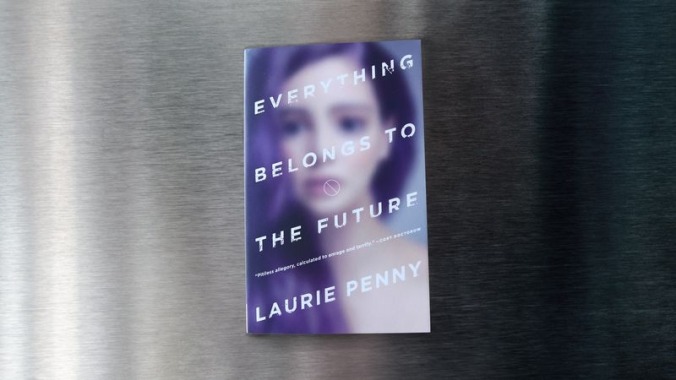Everything Belongs To The Future in Laurie Penny’s poisoned fountain of youth

Journalist and author Laurie Penny’s first foray into long-form fiction takes its title from Louise Michel’s poem “L’œillet Rouge”:
Go, bloom near the somber captive
And tell him/her truly that we love him/her.
Tell that through fleeting time
Everything belongs to the future
That the livid-browed conqueror
can die more surely than the conquered.
The invocation of Michel, an anarchist and preeminent figure of the 19th-century labor movement, effectively sets the stage for Penny’s sci-fi novella. Set in the year 2099, Everything Belongs To The Future concerns a future where, if you can afford it, your life and your youth can be extended indefinitely. A group of apparently young radicals, plus the corporate scientist largely responsible for this fountain of youth, take it upon themselves to reverse the super-wealthy’s fortunes and return things to their natural order.
Like Michel’s poem, Penny’s novella labors under the optimistic belief that oppression and oppressors can be felled, and like Michel, Penny girds this belief with an emphasis on an admix of anarchy and socialism. Penny, who often writes about contemporary feminism and its intersections with neoliberal capitalism, sets her politics as the cornerstone of the text—much to the story’s benefit—and she offers an imaginative feat of speculation. She conjures a compelling miracle of science, and she projects that idea into the future. The plot hinges on being repulsed by this inequality, and it gives the text a certain propulsive drama. With an energetic prose style—short paragraphs that betray her tenure as a journalist and lush, descriptive sentences—Everything Belongs To The Future offers a latter-day pulp. Though, like the mid-century sci-fi it invokes, Everything is not without warts.
In many places, Penny’s novella, rich with the stuff of sci-fi classics and moving at a rapacious clip, is genuinely fun to read. Take this, for instance: “The music came in relentlessly—malevolent pop, catchy as an intimate rash.” Concise and clever, the line gives readers a powerful, relatable image (or sound, as it were) and rolls off the tongue with an effortless grace. These moments, however, make Everything’s missteps all the more frustrating. The novella reads more like a play, with Penny confining her characters to a few small, sparsely defined spaces, and as a result, our understanding of the world outside those spaces is severely limited. We get glimpses, of course, but no allusion, description, or detail significant enough to understand the world of Everything Belongs To The Future. The most glaring instance of this is that we never truly get a sense of how this youthful technology has reorganized society, and to what degree it has exacerbated its ills.
When Penny does offer glimpses into her imagined future, it is often to our chagrin: a feminist enclave named after Anita Sarkeesian, Halo 17, and “a Serbian philosopher who is apparently a big deal right now” (a more debatable reference, though it reads as an invocation of Slavoj Žižek, the Occupy movement’s intellectual point guard). Penny affects a lovely free indirect style; the voice of her omniscient third-person narrator sometimes converges with that of a scene’s central character. And yet, her narration is still dotted with hackneyed references. These lines and artifacts that Penny populates her world with feel stale; in fact, they read as overly clever and sometimes juvenile. Cheap bobbles, they belie the more polished jewels in the novella’s collection.
Ultimately, Penny’s timid painting of her world undercuts the core intellectual argument of her novella. In one of many epistolary interludes, a character writes from her prison cell that, “We discovered the fountain of youth, and then we put it behind high walls and poisoned its promise.” Pervading the text is the notion that technology is neither good nor bad; it has here, unfortunately, been used in the service of bad—as it often is under capitalism. And yet, Penny fails to make this argument felt in any tactile or discernible way. To be sure, the argument is a salient and compelling one, and the characters of Everything say the right things. But the book fails to demonstrate the argument’s veracity; instead, it feels hollow, abstract, and purely rhetorical.
Everything Belongs To The Future excites and irritates in equal measures. It asks thoughtful and compelling questions, and Penny’s prose frequently, and charmingly, recalls the prose of pulpy ’50s science fiction. Conversely, it sometimes feels undercooked and dabbed with the hallmarks of more juvenile writers (as those pulps often do). While it is ultimately unsatisfying, Everything Belongs To The Future is a compelling fiction debut from Penny. It separates itself from its peers by offering enough thoughtful storytelling to be frustrating when it fails to live up to that potential.
Purchasing Everything Belongs To The Future via Amazon helps support The A.V. Club.